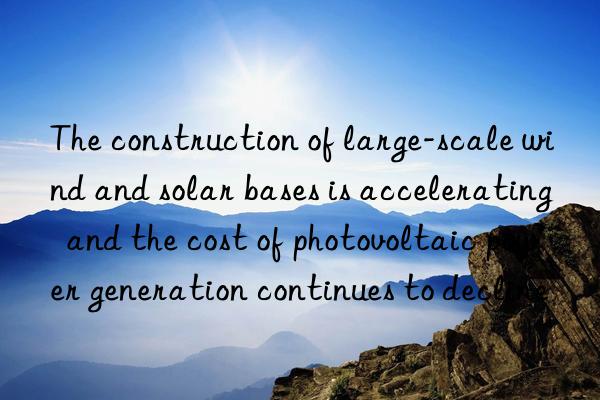
The National Energy Administration recently released the "Guiding Opinions on Energy Work in 2023", which clearly states that this year it is necessary to consolidate the development advantages of the wind power photovoltaic industry and promote the first batch of large-scale wind power photovoltaic bases focusing on deserts, Gobi, and desert areas The project will be connected to the grid and put into production, and the second and third batches of projects will be constructed. The annual wind power and photovoltaic installed capacity will increase by about 160 million kilowatts. Compared with the new installed capacity level in 2022, the new target scale has been further improved.
Industry insiders believe that technological improvement is the key to promoting the rapid development of new energy and helping the realization of the "double carbon" goal. It is expected that the cost of photovoltaic power generation will continue to decline in the future.
In recent years, my country's energy green and low-carbon transformation has achieved positive results. In 2022, the newly installed capacity of wind power and photovoltaic power generation across the country will reach 125 million kilowatts, exceeding 100 million kilowatts for three consecutive years, setting a record high. The installed capacity of renewable energy will exceed 1.2 billion kilowatts by the end of 2022, accounting for 47.3% of the total installed capacity of power generation in the country, an increase of 2.5 percentage points from 2021.
At the "8th China Energy Development and Innovation Forum" held recently, Li Wenxue, Secretary of the Party Committee and Vice President of LONGi Green Energy Technology Co., Ltd., believes that photovoltaics will play an important role in the global energy transformation. He said that in order to achieve the goal of carbon neutrality, electricity will become the main energy carrier in the world's energy structure in 2050, accounting for 51%. Among them, photovoltaic power needs to account for nearly 50% of the future renewable energy-based power system. In 2050, the total installed capacity of photovoltaics needs to increase to 24 times that of 2018.
In order to promote the large-scale development of renewable energy such as wind power and photovoltaics, my country is accelerating the construction of large-scale wind power photovoltaic power generation bases focusing on deserts, Gobi and desert areas. Zhang Yiguo, member of the Party Committee and chief planner of the General Institute of Hydropower and Water Conservancy Planning and Design, introduced that my country has planned a series of projects in the Kubuqi Desert, Ulan Buhe Desert, Tengger Desert, Badain Jaran Desert, coal mining subsidence areas, and other deserts. A batch of large-scale wind power photovoltaic power generation bases, mainly involving Inner Mongolia, Gansu, Ningxia, Shaanxi, Shanxi, Xinjiang, Qinghai and other provinces. By 2030, the total installed capacity of planned wind and solar bases will reach 455 million kilowatts.
Recently, the Ministry of Natural Resources, the National Forestry and Grassland Administration, and the National Energy Administration jointly issued the "Notice on Supporting the Development of the Photovoltaic Power Generation Industry to Standardize Land Use Management", giving priority to including large-scale photovoltaic base land in the list of key project plans; advocating strict protection Under the premise of ecology, encourage the construction of large-scale photovoltaic bases in deserts, Gobi, deserts and other regions, and encourage the use of forest light/grass light complementary models.
According to the information disclosed by the National Energy Administration in February, the construction of large-scale wind power photovoltaic bases focusing on deserts, Gobi and desert areas is progressing smoothly. The first batch of 97.05 million kilowatt base projects has been fully started, and some of them have been completed and put into operation. Some projects of the second batch of bases have started construction one after another, and the third batch of bases has formed a list of projects.
Li Chuangjun, director of the New Energy and Renewable Energy Department of the National Energy Administration, said at a series of press conferences on the theme of "Comments from Authoritative Departments" held recently that the next step is to promote the green and low-carbon transformation of energy and continue to increase the supply of non-fossil energy. Accelerate the adjustment and optimization of the energy structure, and increase the proportion of non-fossil energy consumption by about 1 percentage point annually by 2030.
It is worth noting that new energy technology innovation has become an accelerator for energy transformation, a number of advanced technology and equipment such as high-efficiency photovoltaic power generation and large-capacity wind power have maintained world-leading levels, and many major technological innovations such as independent third-generation nuclear power and large-scale energy storage have achieved new breakthroughs .
According to the deployment of the National Energy Administration, the next step will be to strengthen the guarantee of green and low-carbon technology innovation and transformation mechanisms, increase the efforts to tackle key problems in low-carbon, zero-carbon and negative-carbon technologies, and continuously improve the institutional mechanisms and policy systems to promote energy transformation.
"In the future, the cost of photovoltaic power generation will continue to decline. Cost reduction and efficiency increase are the unchanging essence of the photovoltaic industry, and continuous technological progress is the biggest driving force for the decline in the cost of photovoltaic power generation." Li Wenxue said that in the global photovoltaic market in 2022, China's new Increased photovoltaic capacity accounted for 35%, and module output accounted for 84%. A 1% increase in the efficiency of photovoltaic modules is equivalent to a 4% to 7% reduction in the cost of electricity.



 微信扫一扫打赏
微信扫一扫打赏
